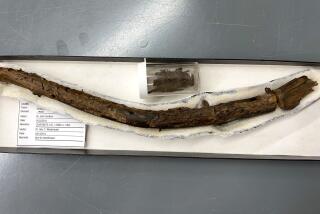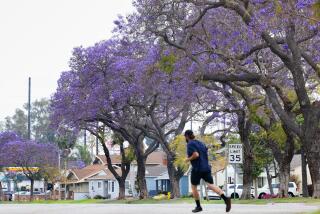Santa Rita prickly pear -- a summer splash of purple in the garden
- Share via
Prickly pear cactuses are so common in Southern California that they blend into the background, even now when the fruit, or tunas, are turning red-purple and dropping off.
For the Santa Rita variety (Opuntia violaceae var. santa rita), it’s not about the fruit but rather the ornamental appeal. During stress from cold or drought, the palm-sized paddles turn a brilliant red-purple, adding a bright splash of color to the monotones of a dry garden.
This is an accent plant that requires almost no care, especially if you want the color. In spring, when a profusion of blooms arrive, it’s merely icing on the cake.
“They produce a peach flower and then that becomes a marble yellow,” said Roy Dowell. He and his partner, Lari Pittman, both artists, have Santa Ritas planted in a three-quarter-acre garden in the Verdugo Hills. “They get tunas but they’re very small, not like the other opuntias. And the deer don’t bother them, surprisingly.”
Molly Thongthiraj of California Cactus Center says that’s because of the small clusters of tiny barbed spines that can fly off the paddle with the slightest movement.
“The deer will try the young ones but then they grow back even more spiny,” she said. “The spines are small but painful and hard to get out. They just fly all over your clothes, even your lungs. That’s why we don’t move them much.”
She suggests wearing leather gloves and clothes that you don’t mind discarding. Given that the spines are so fine and travel so easily in the air, you’ll probably need to throw them away. Her advice: Wear an old painters jumpsuit for maximum protection. (You can remove spines from skin by applying an adhesive such as duct tape or Elmer’s glue to the afflicted area.)
Once the Santa Ritas are in place, Thongthiraj said, forget about them. The only time to consider watering is during the hottest days of the summer, and even then, no more than weekly. Given water (or shade), these cactuses will stay green. To heighten the coloration, Thongthiraj positions plants close to a source of radiant heat, such as next to a wall.
Santa Rita prickly pears adapt to bad soils, even clay, but won’t do well in a commercial cactus mix. The peat moss in most mixtures is too acidic. If planting from a recently cut paddle, let it harden off for two weeks before putting it in the ground. Add mycorrhizal fungi to aid root development, and water sparingly for the first month. Then do nothing.
The less water they get, the more purple they become. They’re slow-growing compared with other opuntias, rarely getting higher than 6 feet. Sources include California Cactus Center and Worldwide Exotics.
The Global Garden, our series looking at the cultures of L.A. through the lens of the city’s landscapes, appears here on Tuesdays.
ALSO:
Planting heirloom Floriani corn
Homegrown fennel pollen, seeds
JOIN THE CONVERSATION:@latimeshome | pinterest.com/latimeshome | facebook.com/latimeshome | facebook.com/latimesgarden






